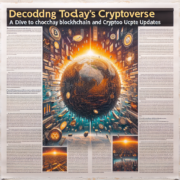The most notorious and feared kinds of crypto attacks may have quite the poetic solution. That’s what Horizen, the victims who suffered such an attack earlier this year which cost them $500 000 claims. The company formally known as Zencash pegged the term 51% attack following their loss.
What is a 51% Attack?
For the newbies out there, a 51% attack occurs when one single malicious miner has control of more than 51% of the computing power on a blockchain network & has the ability to incorporate false transactions onto the network.
Horizen released a paper yesterday which claims they may have found an innovative solution which involves the updating of their proof-of-work consensus algorithm utilising an apparent “delay function” which will penalize miners who have the bravado to prepare for attacks of this nature. Of course, Horizen is an off-shoot of privacy drive Zcash which is an offshoot of bitcoin.
For a miner to pull off a successful 51% attack he/she would need to create secret blocks before adding them to a blockchain, Rob Viglione, co-founder of Horizen claims that their delay function will implement penalties which would make these attacks extremely expensive.
“So what it does is essentially it poses a massive cost, a 10x cost, on trying to launch one of these attacks,” said Viglione.
This 51% attack style has crept in the collective awarenesses of many crypto junkies this year due to 5 major cryptocurrencies losing money during the attack back in June this year.
These attacks also damage the general public’s sentiment towards crypto security and Viglione describes them as a “negative externality on the entire industry.”
After the attack which added 36 fake blocks to the blockchain, Horizen now had direct insights into how to combat this:
“Right after the attack our engineers started brainstorming and we think we have a very elegant, simple solution to make sure that this doesn’t happen again.” claimed Viglione.
“Technically, to make it costly if it were ever to happen again.” he added.
How Would These Penalties Work?
In order to achieve this, Horizen proposes the idea of penalizing any delayed blocks that may be added to the blockchain after an extended period of time after the latest block.
The longest chain rule now has a delay function, as the new code will modify the underlying consensus algorithm.
Say, for example, a block is proposed on the network but it is 5 blocks or more behind the latest block, this is where the penalty will occur. This, as a result, will quadratically increase the amounts of blocks a malicious miner would require to produce to successfully have all his/her transactions approved on the chain.
As a result, voila, chances of a 51% attack are now diminished.
Due to the nature of Horizen’s build, this penalty will only take place if the miner is indeed malicious said, Viglione.
“We have an average block find time of 2 and a half minutes, maximum latency to broadcast anywhere in the world is like one or two seconds, so there’s no way you could be 5 blocks behind legitimately,” he went on to explain.
Viglione did note that this could potentially result in a network partition to occur on the network, due to the fact that multiple chains of blocks will compete to be approved as a legitimate chain but in this case, he explained that miners will be allowed to vote to decide on which chain is honest.
“They essentially elect which chain is legitimate and they start mining on that just like they would any longest chain rule,” he explained.
In order to prevent these network splits from remaining permanent, Viglione explained that the penalties will decrease across the chain that is accepted.
“Blocks are added and there’s a negative one decrement to the penalty that was previously assessed, so there’s always a convergence that can happen to prevent the network partition being permanent,” he explained.
Can It Be Done?
Along with the release of Viglione’s paper, a white paper stated that should a chain of blocks be rejected due to being too far behind the most recent one, exchanges are likely to freeze suspicious deposits until such a time that the situation is fixed.
Viglione also went to on to explain that the specifics of penalties could be tweaked if need be and a this would be dependant on network conditions. 
“We can tune and dial up the cost if we ever think it’s insufficient relative to hashrates and all that,” he explained.
It goes without saying that one must consider that these ideas have been the subject of research for quite some time and many other bigwigs are sceptical that Horizen can live up to these claims.
Vlad Zamfir, leading ETH proof-of-stake researcher said that while he was yet to scratch around in Horizen’s new code, “the design space doesn’t include miracles.”
Ouch. In addition to Vlad’s boisterous statement, Emin Gur Sirer a consensus researcher also expressed his sceptical views by saying: “these protocols are subtle and difficult to get right.”
Viglione is confident, however, with several months of testing that his new algorithm works & that it could ultimately be the code to set an example for the crypto sector on a whole.
“We’ve been testing it internally for a little while now, a couple of months, so we’re pretty confident with the code,” said Viglione adding: “I’d imagine that other projects should, they really should update their code as well.”
Could this be the miracle answer to 51% attacks? Or a wild goose chase? Let us know your thoughts.
Follow CoinBeat on Facebook, Twitter & Telegram
Subscribe to our CoinBeat Newsletter
Submit an article to CoinBeat
View live Marketcap Prices here





Comments